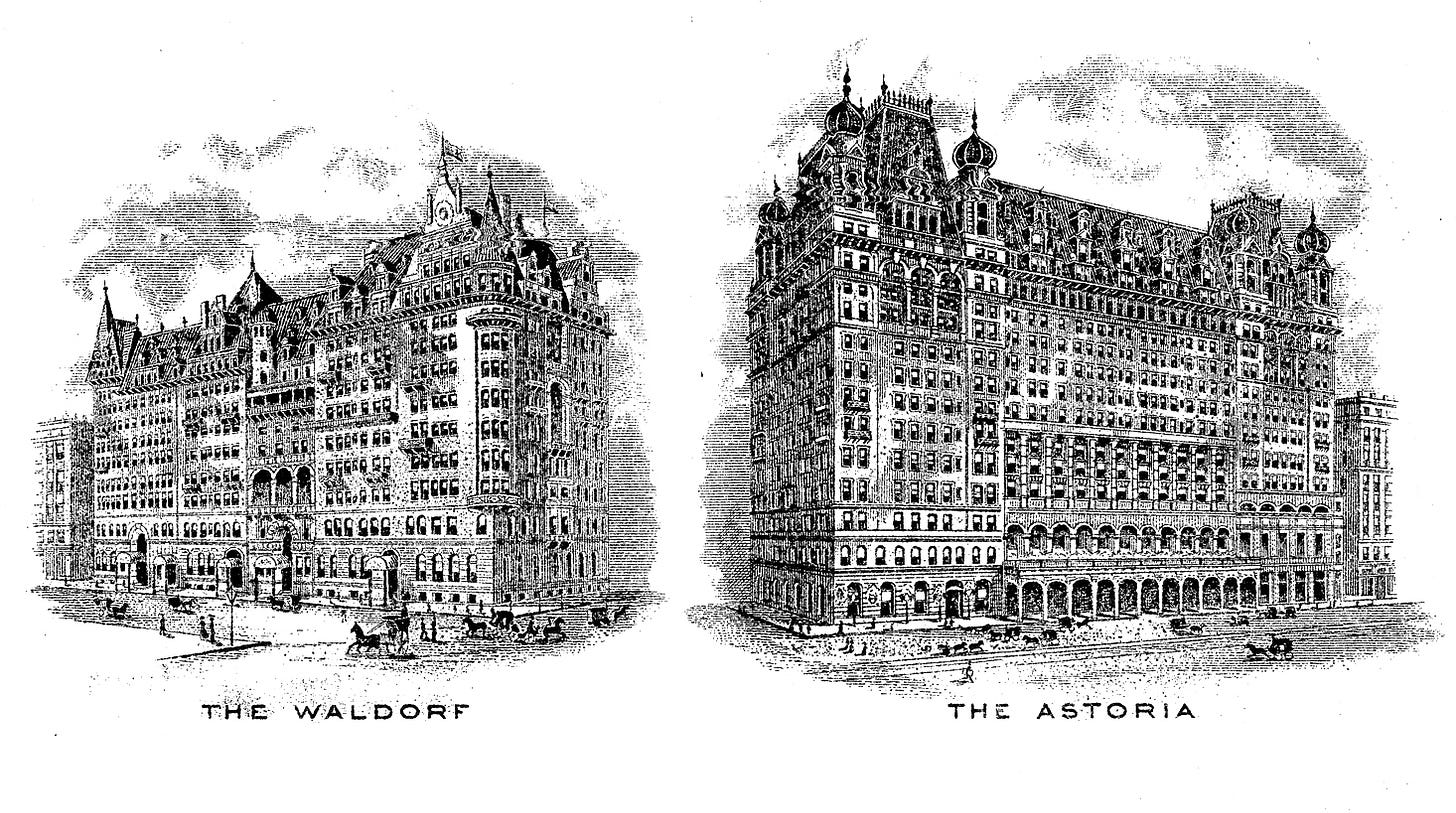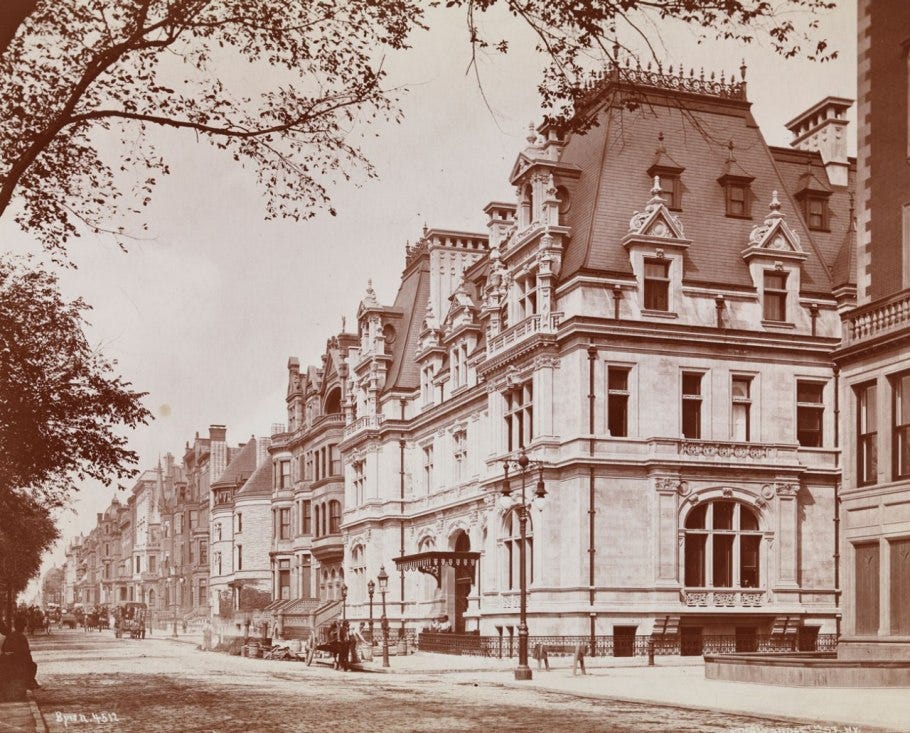A Tale of Two Astors
How Mrs. Astor won the family war for her title, but, was she really the loser?
The name Astor is synonymous with the rise of America. Before the Gilded Age, John Jacob Astor arrived from Waldorf, Germany with great ambition that was realized beyond measure in the early years of America. The Astor fortune came through a fur trading business and it continued to grow through wise stewardship including heavy real estate investment in New York. It is said that John Jacob’s wife, Sarah Cox Todd was extremely shrewd and had very good judgement. She was a great help to her husband in building their empire. John Jacob and Sarah had eight children, but for the sake of this post, it is the descendants of their second son, William Backhouse Astor Sr. that we will be focusing on.
William Backhouse Astor Sr. lived from 1792-1875, and he was the primary inheritor of his family’s fortune. Even though he was a second son, his older brother John Jacob Astor Jr. did not have a strong mental or physical constitution and his two younger brothers passed away in childhood and infancy. William Backhouse worked with his father and it was after receiving an inheritance from his childless uncle and then eventually from his father that he became the most wealthy man in America. He, like his father, invested heavily in real estate, the railroads and more. It is with William Backhouse Senior’s two sons that our Tale of Two Astors really begins.
John Jacob Astor III was the elder son of William Backhouse Sr. and like his father, he was a major success when it came to managing real estate. (Although, it was in his time that Cornelius Vanderbilt overtook the Astors in the railroad industry.) It was John Jacob III’s younger brother William Backhouse Astor Jr., who was married to the famous Caroline Schermerhorn Astor, the woman who history remembers as “Mrs. Astor.” Because she was married to a second son, Caroline Astor was never meant to be THE “Mrs. Astor” but always “Mrs. William Backhouse Astor” as her husband was never to be the patriarch of the family. To add “insult to injury” Caroline saw herself as marrying down because although the Astor’s were the wealthiest family in America, they did not have the birth that she could boast. The Schermerhorns were one of the original Dutch families who settled in New York (originally called New Amsterdam) and her husband was the grandson of a nondescript German immigrant who came to New York and happened to become a business and real estate tycoon. It was Caroline Astor and her famous friend Ward McAllister who, when putting together a list of those who would make up New York’s polite society, said that being a fourth generation gentlemen would be an adequate cutoff to make it in. A requirement that was conveniently overlooked for her husband William Backhouse Jr. and his brother John Jacob III, as there were merely third generation..
The tale of this family really begins to diverge with the death of John Jacob III. Upon his death, his son, William Waldorf Astor (Caroline’s nephew) technically became the patriarch of the Astor family. This family change was not something that was going to be accepted by his next door neighbor and aunt, Caroline Astor. In the regular tradition of American Society, the calling cards of William Waldorf’s wife Mary (often called Mamie) were changed to “Mrs. Astor of Fifth Avenue”, as she was now THE Mrs. Astor since she was married to the family patriarch. Her ambitious Aunt Caroline also had her calling cards remade saying the exact same thing since she also lived on fifth Avenue, right next door to her niece and nephew. As the story goes, her nephew’s efforts to get her to correct her cards were unsuccessful as she said she was the more senior “Mrs. Astor” because she was older. Tensions rose, and eventually William Waldorf tore down his fifth Avenue home and built the Waldorf Hotel at the same location. The loud and continuous construction was a thorn for Caroline and eventually her son John Jacob IV (who would later die on the Titanic) convinced her to tear down her house, and they too built a hotel, The Astoria. Caroline and her son John Jacob IV moved further down Fifth Avenue where they built an enormous double mansion, and the Waldorf and Astoria hotels eventually merged and became The Waldorf-Astoria.
At this point, both William Waldorf and his Aunt Caroline had each won a couple of the battles, but, it would be Caroline Astor who would win the war for the title of Mrs. Astor. Amidst all of the family drama, William Waldorf decided to move to England with his family. His father also had an affinity for England, and William Waldorf would eventually remark that, “America was not a fit place for a gentleman to live.” And so, with the departure of her nephew and his family, it was in fact Caroline Schermerhorn Astor who could claim the title of “Mrs. Astor.” A title by which history has remembered her for over a century.
What Caroline, who passed away in 1908, did not live to see however is the ascension of her nephew into the British peerage. Something that I am sure would have been nearly impossible for her to swallow had she been alive. William Waldorf immigrated in 1891, and became a British citizen in 1899. He was incredibly philanthropic with his fortune and because of that, he was made Baron Astor in 1916, and Viscount Astor in 1917. His son Waldorf would inherit the title of Viscount Astor and his son John Jacob Astor V would be given the title of Baron Astor of Heaver (His father William Waldorf purchased Heaver Castle in 1903 and restored/lived in it.) So, unfortunately for the ghost of Aunt Caroline, her nephew not only became a peer but also was the father of two British peers (not to mention his daughters who married well) who’s descendants are still going strong in England today.
Back in New York, the legacy of Caroline’s children would not turn out to be quite what she had hoped. Two of her children would divorce, something for which she had no tolerance, and as stated above, her son John Jacob IV would tragically die on the Titanic. At the time of his death his second wife who survived the Titanic disaster was pregnant with their son, John Jacob VI. He already had a son and daughter from his first marriage, and per his will, it was his oldest son William Vincent (called Vincent) who would inherit the bulk of his fortune. His second wife Madeline, as well as any children that they might have had were also very well looked after per his will. So, his son John Jacob VI was also a very wealthy young man, but not in the league of his older half-brother Vincent. These grandsons of society queen, Mrs. Astor would have a terrible relationship fraught with negative attention and legal battles as John Jacob VI tried to sue his brother for more of their father’s fortune, even though he really had no grounds to do so. John Jacob VI never won any of the legal battles.
Vincent who was sterile, would marry four times and it was his last wife Brooke Astor who would partner with him in setting up their enormous charitable foundations. She is credited with helping to rehabilitate the Astor name in America after years of legal scandals. She was the one who inherited the bulk of her husband’s fortune and upon her death most of it was given to charity and left in a trust. As for John Jacob VI, he did have a son and daughter, and he does have descendants alive today. But as for the American Astors, their fortune, fame and influence is fragments of what it once was. (Keep in mind that if American’s practiced Primogeniture, John Jacob VI would have been the heir of Vincent whether he liked it or not.)
As an American myself, I have thought (probably far to much) about the drawbacks and benefits of different systems of inheritance. In Britain, the nobility practices primogeniture which of course, is deeply unfair as the oldest son almost always inherits everything. In America, we don’t use this system, and even though in the Gilded Age inheritance practices were more similar to primogeniture, it still was much more evenly divided. While more fair for the descendants, what it means is that these large families die out in a matter of a few generations. Their houses are torn down, and the influence of their families disappear as quickly as it was gained. With these rapid changes, the history of our nation, and the people who helped make it what it is become lost and quickly forgotten. News anchor Anderson Cooper, who wrote a book about the rise and fall of the Astors, talks about meeting Brook Astor, (Granddaughter- in- law of Caroline Schermerhorn Astor) for lunch as a child with his mother, Gloria Vanderbilt. He remarks in an article where he discussed his book, that looking back, their meeting for lunch was a lingering of a bygone era as they were in some ways the last of two enormous family legacies that came, changed America and the world, and went in the matter of about six generations.
Is one system better than the other? I don’t know. They both have their positives and negatives. And personally, I admire how Americans can move with the times and that America is truly a land of opportunity where people can earn their way up, but I hate that we don’t value our history like other countries do. In the tale of the two Astor families, while Caroline, certainly won the war for the title of Mrs. Astor, I don’t think that, in hindsight, she won the war for the enduring legacy that her nephew has through his descendants in England. And, as a result of this, one of America’s most influential families now has very little history left of itself in America, and instead it is lost to England.
If you found this interesting, be sure to check out this article that I mentioned!
https://www.cbsnews.com/news/anderson-cooper-on-the-rise-and-fall-of-the-astor-fortune/
Until Next Time,
McKenzie





